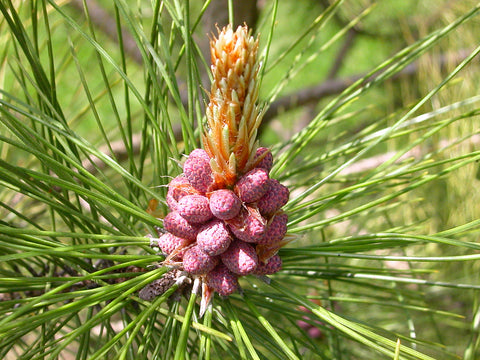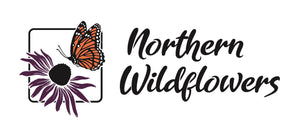Foraging Pine Pollen
Collecting spring pollen from male cones of the red pine tree (Pinus resinosa) is not the most common type of foraging but it's a unique way to add another level to a meal whether it be for meaning or appearance. Pine pollen is 30 percent protein by weight, contains all 9 essential amino acids and has health benefits for athletes due to its ability to stimulate the production of nitric acid, which helps dilate blood vessels and increase blood flow. The taste can be described as mild, pleasant and almost a bit cheesy or yeasty.
My initial motivation for collecting pine pollen was a recipe video I saw online but after trying it I had to find other uses for the rest of my pollen. Spring pine pollen foraging has now turned into a yearly tradition. The bright golden yellow colour of the pollen is so alluring as well as how the pollen grains are so fine and heavy they move like sand. The texture of pine pollen is great for dredging fish and for garnishing dishes with a streak of vibrant yellow.
Harvesting the male cones of the red pine is a labour intensive process but of so satisfying. Scouting out your harvest location is important for the process, there are many red pines too tall to collect from without some type of ladder so you want to find a stand that is growing male cones closer to the ground.
In much of Eastern North America, there are more than enough red pine trees to change your location every year!

Collection
During the first week of June there are only a couple of days when the pollen is mature enough to harvest and the cones not yet fully open, the window to collect red pine pollen is brief. Keep in mind that cones with more exposure to sunlight will mature and open faster than ones that are more shaded. You’ll need a clean and dry five gallon bucket with a lid, which you’ll also use for cleaning, and a pair of garden trimmers. Before the pollen is ready the cones will be a reddish colour, then when it is time to harvest they will start showing yellow with the red. Once the whole cone turns yellow it's too late, the pollen has been released. Harvest the cone by snipping it off the end of the branch. I have found that it is very difficult to reach most male cones so the trees typically only offer you a small amount. However, the smaller trees with easier to reach cones are what you want, but be sure to avoid over-harvesting. As a rule of thumb harvest no more than 10% of any wild crop.

Cleaning
It is important to start the cleaning process immediately following collection because the pollen is very perishable. Add your collected cones into a clean and dry five gallon bucket with a lid. Shake the bucket and cones for a minute or two to coax the pollen out of the open cones. Collect the pollen from the bucket and sift it multiple times. This pollen was meant to be spread by the wind so it will get airborne, do your best to contain it but it is definitely recommended to do this in a garage or shed. Put the shaken cones in a dehydrator for 24 hours to release the remaining pollen and repeat the process of shaking and sifting.

Storing
Pine pollen needs to be stored in the freezer. If you are looking to store in the freezer for longer periods of time it is beneficial to remove as much moisture content as possible. This can be done by spreading the pollen on sheets and putting it in a dehydrator for 24 hours to dry it out as much as possible. As I mentioned before, the pollen has evolved to become airborne so do this very gingerly. Properly stored pollen will easily last a year in the freezer so you can enjoy vibrant yellow additions to your meal all year long.
Adding exciting and natural elements to meals through the foraging season is great for a healthy and active lifestyle. Would you give foraging for pine pollen a try this year?

@Sarah, Oh no! I’m so sorry your pollen didn’t store well due to moisture. It is a more time intensive thing to forage so that must be disappointing. With food safety in general I would say use your judgment and if it doesn’t seem safe or salvageable for a tincture, as sad as it is, I would not recommend you proceed and consume it. If you try again, follow the storage instructions and dry it thoroughly before storing in the freezer.
I didn’t realize the moisture factor of pollen I collected and put it into closed jars in a cabinet. I saw now there is some light mildew on it, maybe throughout it by the slight smell of that. Can this be salvaged in any way? Like making an alcohol tincture which would potentially destroy the mildew factor? As said, this was a labor intensive process for barely 6oz. 😖😕
I didn’t realize the moisture factor of pollen I collected and put it into closed jars in a cabinet. I saw now there is some light mildew on it, maybe throughout it by the slight smell of that. Can this be salvaged in any way? Like making an alcohol tincture which would potentially destroy the mildew factor? As said, this was a labor intensive process for barely 6oz. 😖😕
I have a jar of it in my freezer! Would love to hear the many ways you use it. The last time I went to check to see if a particular tree had pollen, I came face to face with a coyote. We locked eyes in the longest moment I hope never to forget.